There can be many different opinions about Hongkong, but one undisputed fact is that it is a transient place. People come and people go. Things get built, renewed and rebuilt within a few decades. And if a restaurant has been around for 30 years, it is considered an institution.
To understand the restaurant business in this city is to learn about the history of Hongkong. Many of the places frequented by the early colonists, such as the Gloucester Hotel, no longer exist and The Peninsula, especially its lobby, is one of the few places left that offer testimonies to the territory’s colonial splendour centuries ago. To get a taste of causal Western dining from the old days, however, one may head over to Jimmy’s Kitchen.
The original Jimmy’s Kitchen was opened in Shanghai by a retired American navy officer called Jimmy James and his place was more a hangout for sailors than for the suited-up gentlemen. His friend Aaron Landau, who became a fan of Jimmy’s, imported the idea to Hongkong in 1928.
Hong Kong’s Jimmy’s was first opened in Wanchai, featuring bare walls and wooden tables sans tablecloths. But the business was a success and some years later it moved to Central with fancier decors, first on Pottinger Street and then Theatre Lane, until it found its current location on Wyndham Street in the 1970s.
And since then, it seems, time has stopped in this restaurant. Despite having a new owner, much of the restaurant’s furnishings have been preserved – the wood panelling, the leather banquettes and softly-lit ceiling – and this is also one of the few places in the city where one can enjoy a steak Diane and a baked Alaska just the way people have loved them for decades.
At the same time when the British expatriates were frequenting Jimmy’s for a taste of home, the Chinese locals curious about foreign flavours were heading to Tai Ping Koon. Its founder, Chui Lo Ko, worked as a chef in a Western trading company in Guangzhou during the Qing Dynasty and in 1860 started his own restaurant.
Originally it was named Tai Ping Sha, after the area where it was located. It was purportedly the first restaurant in Guangzhou specialising in Western cuisine and served such historically important political figures such as Zhou Enlai and Chiang Kai-shek.
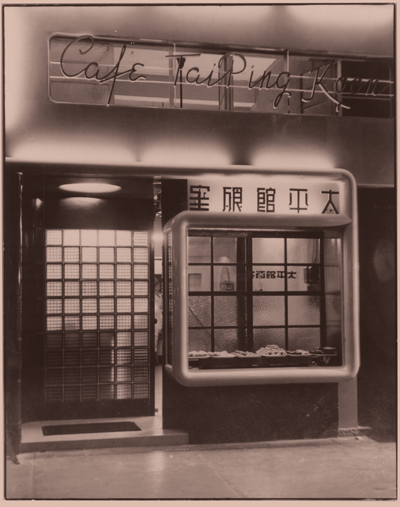
Tai Ping Koon came to Hongkong in 1930s, offering a style of dishes that blended Western recipes with Chinese ways of seasoning. It laid the foundation of what would later be called “soy sauce Western cuisine”, a culinary culture well preserved in Hongkong even today.
At the restaurant’s three locations, the menu hasn’t changed much since the beginning. Dishes such as roast pigeon (with a sauce similar to the sweet soy used in Chiuchow goose, cooked with the bird’s innards for an extra zip), smoked promfret (served with mayo), Portuguese-style baked chicken (in a creamy curried sauce) and the chicken wings in Swiss sauce are still what people come for.
Natives of Switzerland would draw a blank when tasting the chicken wings as there is nothing Swiss about them. Legend has it that the dish was originally called “sweet-sauce chicken wings”, but one of the waiters, not having mastered English, mispronounced “sweet” as “Swiss”. The misnomer apparently inspired the owner to rename the wings as a gimmick.
Hongkong’s dining scene was given a boost after World War II. The war devastated the city and halved its population to 750,000, but after the British resumed control, it enjoyed a long period of stability that laid down a favourable condition for culinary developments. Political changes on the mainland prompted many to seek refuge in the then-British territory, and the population tripled in five years.
Many of the immigrants were from affluent families in major cities, most notably Shanghai and Guangzhou, and they brought with them wealth and family chefs, many of whom would later start their own catering businesses.
Although there were a handful of restaurants around the city, dining out was rare before 1960s. When there were occasions to celebrate, the rich and affluent would host banquets and parties at home with their own kitchen teams taking care of things. The common folk, on the other hand, would seek the help of caterers and have gatherings on the rooftops of their buildings – the only viable venues for them as most people shared flats in those days.
One of the most popular caterers in those days was Fook Kee, founded in 1948. It would eventually find success and become a chain of restaurants called Fook Lam Moon (meaning “fortune comes to your door”), with the first opened in Wanchai in 1972. The specialties are Cantonese marine delicacies, most notably shark’s fin soup and braised air-dried abalones, and HK$3,000 (US$386) only buys you a middle-of-the-range set dinner. Tycoons are reported to have rung up bills each worth the price of a Honda sedan.
When the locals went out to eat in old Hongkong, it was often to the tea houses for dim sum – best described as Cantonese tapas that are mostly either steamed or deep-fried. Two of the surviving historical examples still stand in Central.
Marble table tops, wood paneling and stained-glass windows describe the elegant décor of Luk Yu Tea House, which has been frequented by the well-heeled since it opened in 1933. Named after a legendary tea master in the Tang Dynasty, this place is now a hot tourist destination but in the bygone days, it was like a conference room packed with the business elites.
Luk Yu also serves dinner but it is still the dim sum the place is most famous for. Order your choice of tea and mark on the dim sum list what you’d like and how many. The usual har gau (shrimp dumplings) and siu mai (pork dumplings, sometimes mixed with mince prawn meat and crab roe) are very good but if you want something special, ask for the siu mai topped with a slice of pork liver – it’s a decadent treat of layered flavour and texture.
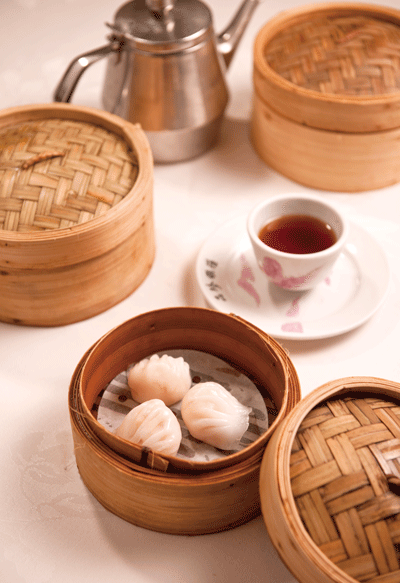
Today, dim sum is seen as a lunch food, but in the old days, people ate it very much all day. That tradition is still upheld at Luk Yu, where the steamers of tasty morsels are served from early in the morning until 6pm. But if you come late, expect a more limited choice of items.
Whereas Luk Yu was for the well-to-do, Lin Heung Tea House nearby was for the masses. Like Tai Ping Koon, this institution originated in Guangzhou and it opened its business in Hongkong in 1926. For many years it was where people in laborers went for breakfast. They would come here at 6am and sit down for a steamer or two of dim sum, a pot of rice dish (chopped pork rib with marinated chicken feet is a popular recipe) and, of course, tea. This would be their main meal before they headed on for a stringent work day.
Lin Heung moved to a new location in 1990s because its former place was being redeveloped – a common Hongkong story – but when you step into the tea house today, you’d think that it has been there forever. Be prepared for a cultural shock. There are spittoons everywhere and you have to rinse your tableware with hot tea (in the big bowl provided by the staff) before you start eating – a ritual still practiced at some dim sum places today.
And the way to order food here is by talking loud. A card is given to you as your bill and whenever you get a dish, the staff puts a chop on it for the record and you pay at the cashier before you go. If you see a dim sum trolley, often pushed about by a dim sum lady, it is acceptable to shout across the table – or even the hall – to ask what’s on offer. Name what you want and the dim sum lady will serve it up.
Besides the usual offers, Lin Heung also serves many dishes that are increasingly hard to find elsewhere, such as vinegared pig’s trotters and “cotton chicken” (min fa gai). The latter is poultry and fish maw or pig’s skin wrapped in a sheet of bean curd skin and steamed. The jus of the meat is absorbed by the fish maw/pig’s skin during cooking, making every bite you take a heavenly experience.
Other than dim sum, the Chinese roasts are also a quintessential Cantonese dish. The one item that has propelled this recipe to international stardom is perhaps the char siu (honey-glazed barbecued pork) but if you ask the locals, they’d tell you that when they want a treat, they go for siu ngor (roasted goose). The crisp skin and fatty meat are what people love about this bird.
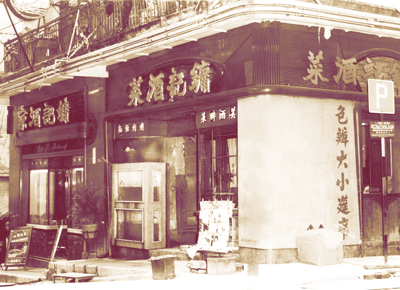
One institution that has built a name on this dish is Yung Kee. Founder Kam Shui Fai began as a dai pai dong (street stall) owner before World War II, serving Chinese roasts near the old Hong Kong-Macau Ferry Terminal. People couldn’t get enough of his food and he eventually made enough to move into a shop on 32 Wing Lok Street in 1942, thus starting the legend that is Yung Kee. His shop was bombed during the war, but when peace resumed he made a comeback at another number 32, this time on Pottinger Street. Success quickly followed again and in 1964, he bought his own building on Wellington Street, probably not so coincidentally at number 32.
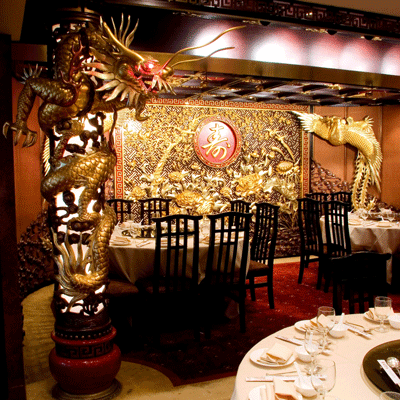
The multi-storey restaurant remains at the same address today and is still run by the Kam family. The menu has long since expanded beyond the roasts, but the signature goose is still a staple on every table. The restaurant farms its own geese in China to ensure quality.
Hongkong saw prosperity after the end of the war, and French cuisine, the symbol of fine gastronomy, came to be popular among the rich. In 1953, Gaddi’s opened at The Peninsula and has since become a classic. The grandeur of the restaurant has remained with the rich blue-and-gold carpeting, long white candles on silver candleholders, luscious drapery and striking chandelier, but at the helm of the kitchen now is 30-something David Goodridge, a protégé of Michelin-star chef Raymond Blanc.
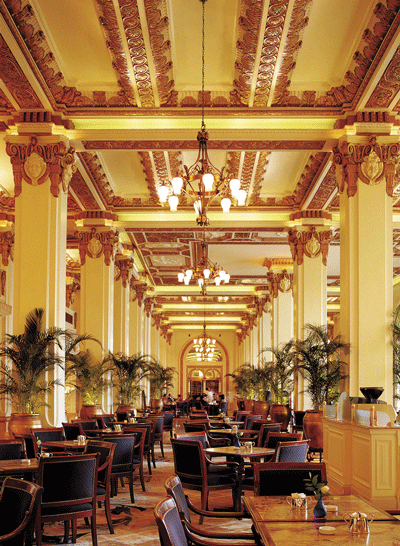
The dishes currently served are in line with the timeless grace that defines Gaddi’s, such as layers of puff pastry with melted goose liver, caramelised onions and smoked bacon; whole-roasted lobster with its lightly whipped jus, semi-dried tomatoes and linguine in Armagnac butter; and grilled suckling pig with braised belly and home- made sausage, Calvados jus. It is a restaurant for special occasions, with the thousand-buck price tag to prove it.
Before the ‘80s, fine dining in Hongkong was found mostly in hotels. A standalone French restaurant would be a rare animal, which was what made the opening of Amigo in the ‘60s so special. Founder and French food connoisseur Yeung Wing Chung realised his dream and opened his original restaurant on Percival Street in 1967 – a turbulent year in the modern history of Hongkong as street riots fueled by ideological differences between communism and capitalism ravaged the city.
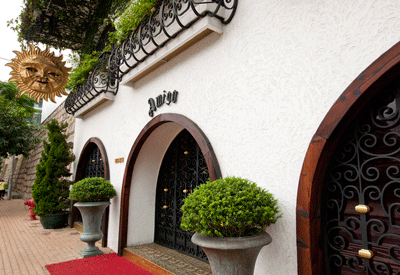
Despite all that, business was good for Amigo. But when the lease was up after a decade, the restaurant needed a new home. In 1976, Mr Yeung found a semi-secluded location on Wong Nai Chung Road in Happy Valley and decided to buy up the first three floors of the building to ensure a permanent home for his culinary haven.
The white stucco façade of Amigo resembles a Spanish villa more than a cottage in the French country and it stands out as one passes by en route to the town of Happy Valley. But many make this place the destination. The interior is also more Iberian than anything, but the carved wood furnishing and oil paintings do certainly give the place an understated grandeur that makes you forget you’re in Hongkong.
Very few diners leave this place unhappy as the tuxedo-clad waiters go out of their way to make guests feel special.
Loyalists swear by the lobster bisque (or for something different, try the bisque d’escargots), seared fois gras served with turnip, filet de boeuf au fois gras et jus de truffes and prawns au gratin. The puffy and creamy cake Napoleon is one of most ordered desserts.
These are just some of Hongkong’s institutions, of course. There are also many old-time Shanghainese, Suzhou and Hangzhou restaurants as well as a notable presence of sushi eateries resulting from the city’s close business ties with Japan in 1980s.
But the one point illustrated by the development of Hongkong’s dining culture is that this city has always been an outward-looking place and a town that strives to move forward. “Change” is the staple on the menu, which is why old restaurants are such gems to treasure.








